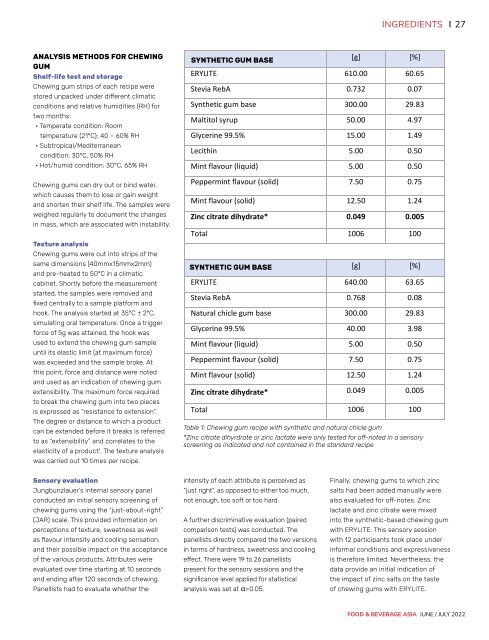Food & Beverage Asia June/July 2022
Food & Beverage Asia (FBA) is the leading source of food and beverage news in Asia since 2002. FBA delivers a comprehensive view of the food and beverage landscape, spanning across the latest health and nutrition trends and industry innovations in ingredients, recipe formulations, food science, sustainability, packaging, and automation, as well as advancements in agri and food-tech.
Food & Beverage Asia (FBA) is the leading source of food and beverage news in Asia since 2002. FBA delivers a comprehensive view of the food and beverage landscape, spanning across the latest health and nutrition trends and industry innovations in ingredients, recipe formulations, food science, sustainability, packaging, and automation, as well as advancements in agri and food-tech.
Create successful ePaper yourself
Turn your PDF publications into a flip-book with our unique Google optimized e-Paper software.
INGREDIENTS 27<br />
ANALYSIS METHODS FOR CHEWING<br />
GUM<br />
Shelf-life test and storage<br />
Chewing gum strips of each recipe were<br />
stored unpacked under different climatic<br />
conditions and relative humidities (RH) for<br />
two months:<br />
• Temperate condition: Room<br />
temperature (21°C); 40 – 60% RH<br />
• Subtropical/Mediterranean<br />
condition: 30°C, 50% RH<br />
• Hot/humid condition: 30°C, 65% RH<br />
Chewing gums can dry out or bind water,<br />
which causes them to lose or gain weight<br />
and shorten their shelf life. The samples were<br />
weighed regularly to document the changes<br />
in mass, which are associated with instability.<br />
Texture analysis<br />
Chewing gums were cut into strips of the<br />
same dimensions (40mmx15mmx2mm)<br />
and pre-heated to 50°C in a climatic<br />
cabinet. Shortly before the measurement<br />
started, the samples were removed and<br />
fixed centrally to a sample platform and<br />
hook. The analysis started at 35°C ± 2°C,<br />
simulating oral temperature. Once a trigger<br />
force of 5g was attained, the hook was<br />
used to extend the chewing gum sample<br />
until its elastic limit (at maximum force)<br />
was exceeded and the sample broke. At<br />
this point, force and distance were noted<br />
and used as an indication of chewing gum<br />
extensibility. The maximum force required<br />
to break the chewing gum into two pieces<br />
is expressed as “resistance to extension”.<br />
The degree or distance to which a product<br />
can be extended before it breaks is referred<br />
to as “extensibility” and correlates to the<br />
elasticity of a product 1 . The texture analysis<br />
was carried out 10 times per recipe.<br />
SYNTHETIC GUM BASE<br />
Table 1: Chewing gum recipe with synthetic and natural chicle gum<br />
[g] [%]<br />
ERYLITE 610.00 60.65<br />
Stevia RebA 0.732 0.07<br />
Synthetic gum base 300.00 29.83<br />
Maltitol syrup 50.00 4.97<br />
Glycerine 99.5% 15.00 1.49<br />
Lecithin 5.00 0.50<br />
Mint flavour (liquid) 5.00 0.50<br />
Peppermint flavour (solid) 7.50 0.75<br />
Mint flavour (solid) 12.50 1.24<br />
Zinc citrate dihydrate* 0.049 0.005<br />
Total 1006 100<br />
SYNTHETIC GUM BASE<br />
[g] [%]<br />
ERYLITE 640.00 63.65<br />
Stevia RebA 0.768 0.08<br />
Natural chicle gum base 300.00 29.83<br />
Glycerine 99.5% 40.00 3.98<br />
Mint flavour (liquid) 5.00 0.50<br />
Peppermint flavour (solid) 7.50 0.75<br />
Mint flavour (solid) 12.50 1.24<br />
Zinc citrate dihydrate* 0.049 0.005<br />
Total 1006 100<br />
*Zinc citrate dihyrdrate or zinc lactate were only tested for off-noted in a sensory<br />
screening as indicated and not contained in the standard recipe<br />
Sensory evaluation<br />
Jungbunzlauer’s internal sensory panel<br />
conducted an initial sensory screening of<br />
chewing gums using the “just-about-right”<br />
(JAR) scale. This provided information on<br />
perceptions of texture, sweetness as well<br />
as flavour intensity and cooling sensation,<br />
and their possible impact on the acceptance<br />
of the various products. Attributes were<br />
evaluated over time starting at 10 seconds<br />
and ending after 120 seconds of chewing.<br />
Panellists had to evaluate whether the<br />
intensity of each attribute is perceived as<br />
“just right”, as opposed to either too much,<br />
not enough, too soft or too hard.<br />
A further discriminative evaluation (paired<br />
comparison tests) was conducted. The<br />
panellists directly compared the two versions<br />
in terms of hardness, sweetness and cooling<br />
effect. There were 19 to 26 panellists<br />
present for the sensory sessions and the<br />
significance level applied for statistical<br />
analysis was set atαα=0.05.<br />
Finally, chewing gums to which zinc<br />
salts had been added manually were<br />
also evaluated for off-notes. Zinc<br />
lactate and zinc citrate were mixed<br />
into the synthetic-based chewing gum<br />
with ERYLITE. This sensory session<br />
with 12 participants took place under<br />
informal conditions and expressiveness<br />
is therefore limited. Nevertheless, the<br />
data provide an initial indication of<br />
the impact of zinc salts on the taste<br />
of chewing gums with ERYLITE.<br />
FOOD & BEVERAGE ASIA JUNE / JULY <strong>2022</strong>


















